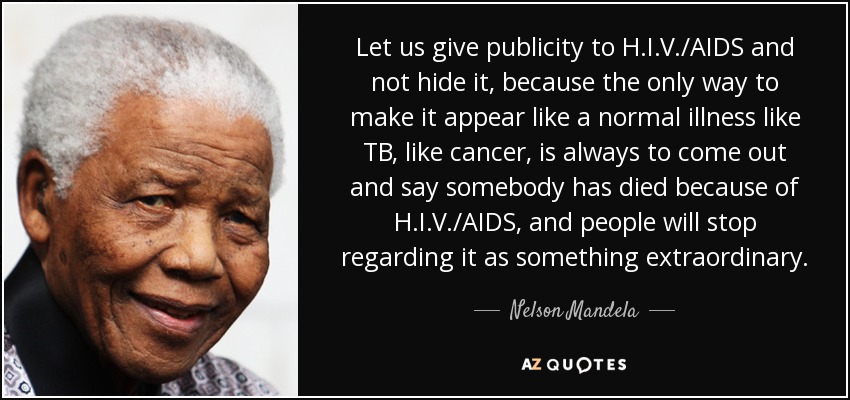AIDS- A Major Health Issue

Kuhu Misra is a second-year undergraduate pursuing law from IP University, Delhi. Apart from being a Bibliophile, she also dabbles in amateur blogging and various oratory programs.
AIDS- A Major Health Issue
It is bad enough that people are dying of AIDS. But no one should die of ignorance.
-Elizabeth Taylor
This quote clearly voices my thoughts on AIDS. In our society, a person affected by AIDS is treated worse than an animal, the primary cause -the disease being of a contagious nature and most importantly, the manner in which it is passed. What we forget is that nobody is perfect. If a certain mistake has taken place there should be a chance to rectify it as even the laws of our country provide some relief to first-time offenders.
AIDS in India is looked down upon and especially if it is detected in a girl or a woman, the character of that female is tarnished for life. No one really bothers to question further as to what might have been the cause of such transmission. Maybe it was through her own husband. Without knowing the cause people try to banish the female from the society. I want to ask, “Is this fair? Is AIDS a certificate of a woman’s character?” It’s definitely NOT. But our country is far from agreeing and accepting this.
Why women are specifically at risk of HIV?
Since the start of the global HIV epidemic, in many regions, women have remained at a much higher risk of HIV infection than men. The reason being gender inequality and intimate partner violence (IPV) prevents women, particularly young women, from protecting themselves against HIV. A number of studies show that IPV increases the risk of HIV infection as well as unwanted pregnancies. For example, a study from South Africa found that young women who experienced IPV were 50% more likely to acquire HIV than those who did not experience violence.
Very high levels of HIV infection are found among young women in relationship with older men. Relationship with large age differences are commonplace in sub- Saharan Africa and are often associated with unsafe sexual behaviour and low condom use due to unequal power in the relationship.
Lack of access to healthcare services and education
A major barrier to women’s health security is the lack of the access which a woman has to it. A lack of access to comprehensive HIV and sexual and reproductive health (SRH) services means that women are less able to look after their sexual health and reduce their risk of HIV infection. Most importantly, the healthcare professionals are often not fully trained as to understand laws around the age of consent and abortion legislation, thus forcing a woman into abortion rather than educating her about the rights and well-being of her unborn child.
Even if a woman is able to get access to a trained healthcare service provider, stigma and discrimination create additional barriers. People being judgemental in nature, deny healthcare service to the victim, while others are coerced into using them.
Another barrier which we talk about is the lack of education. Young girls who attend school are not given proper sexual education in school owing to the corrupt and immoral ideas that this type of education creates. Due to this misconception these young girls have to suffer when they mature and enter into a relationship with a guy. They are unaware as to the harm of not using a condom and given their docile or uneducated nature they are not able to object to their partners about the lack of the use of a condom. Thus, in a way they, too, are responsible for getting themselves affected with HIV.
HIV Prevention Programmes for women
The WHO promotes a number of approaches to help reduce women’s vulnerability to HIV. A few of them are:
CASH TRANSFERS
Cash transfers are social protection programmes often targeted at women in a household to reduce poverty, build human capital and enhance food security.
SCHOOL-BASED INTERVENTIONS
School based interventions aim to promote equitable gender norms before other norms are fully ingrained in the lives of adolescents. Increasingly, school-based curricula are being implemented to address IPV and prevent HIV.
ADDRESSING VIOLENCE IN HIV SERVICES
HIV testing and counselling, prevention of mother to child transmission (PMTCT) and treatment services can address violence towards women in a number of ways. Healthcare workers can be trained to recognise the signs of IPV, promote gender equality in the community, increase women’s access to services and teach women partners communication and negotiation skills.
ACCOUNT OF REAL LIFE SURVIVOR
Nici Bowditch has lived with HIV for 18 years since being diagnosed just at the age of 19. The 36-year-old former banker now lives in east London with her IT worker fiancé Carl, 46.
She had picked the virus from an ex-boyfriend who she had been seeing for two months. They had gone on a holiday to a caravan park where the boyfriend collapsed with pneumonia. He was rushed to the hospital and two days later he told her he was suffering from AIDS.
After the confession she was tested for it and she came out to be HIV positive and was told that she would die within 4 to 5 years. People believed her to be a prostitute as she had acquired the disease whilst the truth was the boyfriend was bisexual and had slept around with 4-5 women. Her family started treating her differently and she was made to pop up 18-20 pills a day.
Such misinformed practice and medication led her to a breakdown although now after much supervised medication and conditioning, Nici is happily married and lives a proper and happy life.
Conclusion
At the end I would just like to quote Nelson Mandela, “Let us give publicity to H.I.V/ AIDS and not hide it, because the only way to make it appear like a normal illness like TB, like cancer, is always to come out and say somebody has died because of HIV/AIDS, and people will stop regarding it as something extra ordinary.”


